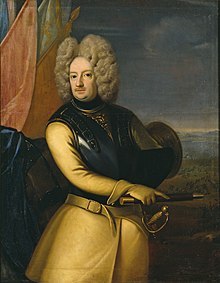
Back ماغنوس ستينبوك Arabic ماجنوس ستينبوك ARZ Магнус Стенбок Bulgarian Magnus Stenbock Catalan Magnus Stenbock Danish Magnus Stenbock (Feldmarschall) German Magnus Stenbock Spanish Magnus Stenbock Estonian Magnus Stenbock Finnish Magnus Stenbock French
Magnus Stenbock | |
|---|---|
 | |
| Born | 22 May 1665 Stockholm, Sweden |
| Died | 23 February 1717 (aged 51) Kastellet, Copenhagen, Denmark |
| Buried | Uppsala Cathedral, Sweden |
| Allegiance | Dutch Republic Holy Roman Empire Swedish Empire |
| Service/ | Swedish Army |
| Years of service | 1685–1717 |
| Rank | Field Marshal (Fältmarskalk) |
| Commands held | Kalmar Regiment Dalarna Regiment |
| Battles/wars | |
| Spouse(s) | |
Count Magnus Stenbock (22 May 1665 – 23 February 1717) was a Swedish field marshal (Fältmarskalk) and Royal Councillor. A commander of the Carolean Army during the Great Northern War, he was a prominent member of the Stenbock family. He studied at Uppsala University and joined the Swedish Army during the Nine Years' War, participating in the Battle of Fleurus in 1690. After the battle, he was appointed lieutenant colonel, entered Holy Roman service as Adjutant General, and married Eva Magdalena Oxenstierna, daughter of statesman Bengt Gabrielsson Oxenstierna. Returning to Swedish service he received colonelcy of a regiment in Wismar, and later became colonel of the Kalmar and then Dalarna regiments.
During the Great Northern War, Stenbock served under King Charles XII in his military campaigns in the Baltic and Polish fronts. As director of the General War Commissariat, Stenbock collected substantial funds and supplies for the maintenance of the Swedish army, earning the admiration of Charles XII. In 1705, he was appointed general of the infantry and Governor General of Scania. As acting governor, Stenbock displayed his administrative skills and organized Scania's defense against an invading Danish army, which he defeated at the Battle of Helsingborg in 1710. In 1712, he conducted a campaign in northern Germany and defeated a Saxon-Danish army at the Battle of Gadebusch, which earned him his field marshal's baton. His career plummeted after his merciless destruction of the city of Altona in 1713. Surrounded by overwhelming allied troops, Stenbock was forced to surrender to King Frederick IV of Denmark during the siege of Tönning. During his captivity in Copenhagen, the Danes revealed Stenbock's escape attempt and imprisoned him in Kastellet. There he was the subject to a defamation campaign conducted by Frederick IV and died in 1717 after years of harsh treatment.
Besides his military and administrative professions, Stenbock was regarded as a skilled speaker, painter and craftsman. His military successes contributed to the creation of a heroic cult in Sweden. During the age of romantic nationalism he was consistently praised by Swedish historians and cultural personalities, such as Carl Snoilsky in his poem "Stenbock's courier". His name has inspired streets in several Swedish cities and in 1901 an equestrian statue of Stenbock was unveiled outside Helsingborg city hall.
© MMXXIII Rich X Search. We shall prevail. All rights reserved. Rich X Search